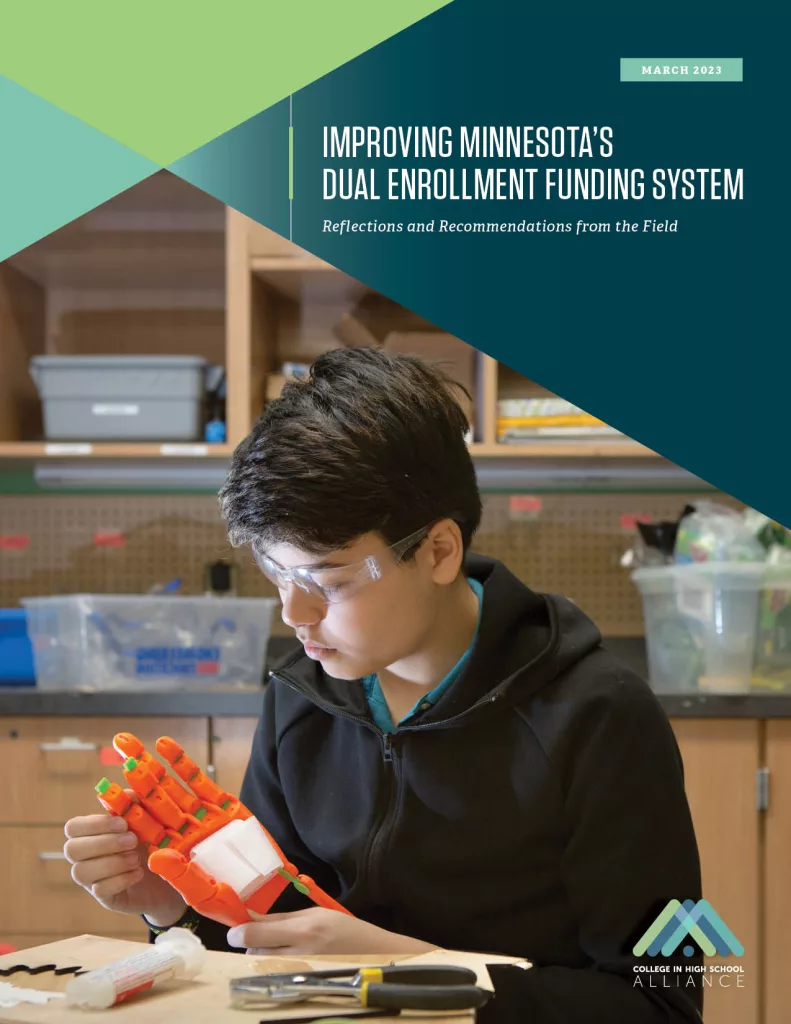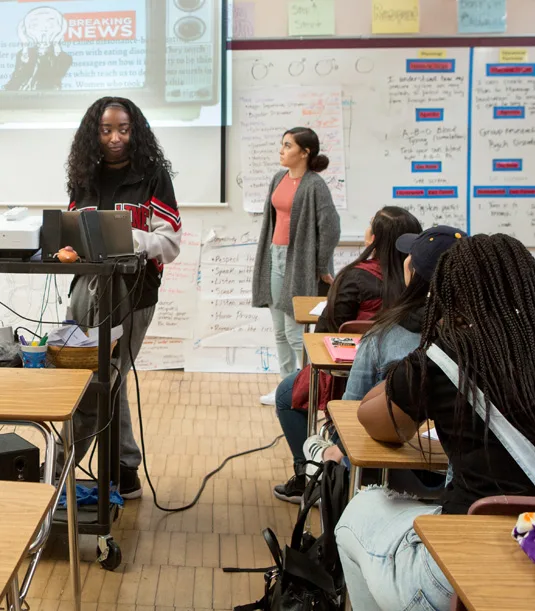Improving Minnesota’s Dual Enrollment Funding System: Reflections and Recommendations from the Field
A Collaborative Vision to Build a More Equitable and Sustainable Dual Enrollment System
March 2023
Minnesota has been a national leader in college in high school programs for nearly four decades, launching the Postsecondary Enrollment Options (PSEO) program in 1985 — one of the first dual enrollment initiatives in the country. Since then, thousands of Minnesota students have earned free college credit in high school through PSEO and Concurrent Enrollment, helping them get a head start on college and career success.
Yet, despite this legacy, equity gaps in access and participation persist, driven in part by how Minnesota funds its dual enrollment programs. Improving Minnesota’s Dual Enrollment Funding System: Reflections and Recommendations from the Field presents the findings from extensive statewide listening sessions with educators and students, facilitated by CHSA in partnership with the Minnesota P–20 Education Partnership. The report outlines actionable strategies for building a funding system that expands access, promotes equity, and strengthens collaboration between high schools and colleges.
What We Heard from the Field
Practitioners’ Perspectives
Educators, administrators, and college partners highlighted the strengths of Minnesota’s dual enrollment ecosystem — including free tuition for students, bipartisan support, and a strong research base demonstrating the benefits of participation.
But they also identified critical challenges:
-
Funding formulas disincentivize participation in PSEO, as high schools lose per-pupil funding when students enroll in college courses.
-
Transportation reimbursement is outdated, leaving many low-income students without access to in-person college experiences.
-
Concurrent enrollment funding is too limited to meet statewide demand.
-
Teacher credentialing requirements remain a major barrier to expanding concurrent enrollment offerings.
Students’ Perspectives
In 22 listening sessions across nine colleges, students emphasized how dual enrollment changed their lives — but also revealed deep inequities in access:
-
Many students learned about PSEO through peers, not their schools, and faced gatekeeping from counselors.
-
Students of color reported exclusionary messaging that made them feel dual enrollment wasn’t for them.
-
Transportation and lack of early information were major barriers.
Despite these challenges, students overwhelmingly said that earning college credit in high school boosted their confidence, saved them money, and helped them prepare for college success.
Principles for Dual Enrollment Funding Reform
The report proposes five guiding principles for reforming Minnesota’s dual enrollment funding system:
-
Keep programs cost- and tuition-free for students.
-
Center all changes on student equity and success.
-
Ensure universal access for any student who chooses to participate.
-
Design reforms that expand opportunities for underrepresented students, particularly students of color, low-income students, and students with disabilities.
-
Promote true partnerships between high schools and colleges rather than competition for funding.
Recommendations for the Minnesota Legislature
To move toward a more equitable and efficient system, the report recommends four key actions:
-
Pilot Full Funding of PSEO with Equity at the Center
Create a statewide pilot to fully fund PSEO, eliminating the financial disincentives that lead schools to limit student participation. -
Update the PSEO Transportation Formula
Modernize the reimbursement mechanism so low-income students can access in-person courses without transportation barriers. -
Collect and Publicly Report PSEO by Contract Data
Ensure all dual enrollment participation — including PSEO by Contract — is tracked and disaggregated to inform equitable policymaking. -
Commission New Research on Dual Enrollment Outcomes
Study participation patterns, economic benefits, and best practices for funding and instruction to guide future policy reforms.
A Model for Other States
Minnesota’s story illustrates a challenge facing many states: how to sustain and expand dual enrollment while promoting equity. The lessons in this report offer a blueprint for any state seeking to align funding with access, strengthen partnerships between K–12 and higher education, and ensure all students can benefit from college in high school programs.
About the Authors
This report was authored by Alex Perry of the College in High School Alliance (CHSA) and Foresight Law + Policy, in partnership with the Minnesota P–20 Education Partnership, Minnesota Department of Education, Minnesota State Colleges and Universities, Minnesota Office of Higher Education, and the University of Minnesota Twin Cities.
Access the paper
Improving Minnesota's Dual Enrollment Funding System: Reflections and Recommendations from the Field


